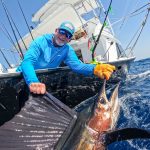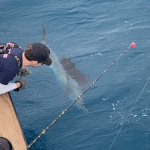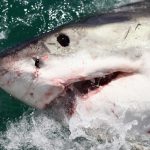
Announcements!
ROFFS™ is Hiring – Position: Satellite Fisheries Oceanographer in West Melbourne, Florida
Scientific consulting company (Roffer’s Ocean Fishing Forecasting Service, Inc. – ROFFS™, West Melbourne, Florida) is looking for a self-motivated, investigative, reliable, positive, and energetic person that will flourish in a challenging deadline and production oriented environment. Candidate should be a self-starter and team player. Position involves processing and analyzing satellite derived oceanographic data (infrared, ocean color, altimeter, etc.), in-situ oceanographic data and model output for several applications including deriving daily oceanographic fishing forecasting analyses (will train).
 Please click HERE to read the full announcement on our website now!
ROFFS™ first official Saturday to be open is scheduled for Saturday, May 6, 2017. We will be open 9:00 am – 5:00 pm (possibly close earlier). Please place your order prior to 12:00 noon on Saturday for Sunday fishing. Please click HERE to place your order on our website today!
Updated Videos on ROFFS™.com – Be Sure to Check Out the “Hot News” Button on the ROFFS™ Homepage
Sailfish!
Please click HERE to read the full announcement on our website now!
ROFFS™ first official Saturday to be open is scheduled for Saturday, May 6, 2017. We will be open 9:00 am – 5:00 pm (possibly close earlier). Please place your order prior to 12:00 noon on Saturday for Sunday fishing. Please click HERE to place your order on our website today!
Updated Videos on ROFFS™.com – Be Sure to Check Out the “Hot News” Button on the ROFFS™ Homepage
Sailfish!
 The fastest fish in the ocean, sailfish can reach speeds of 68 miles (110 kilometers) per hour.
They are members of the billfish family, and as such, have an upper jaw that juts out well beyond their lower jaw and forms a distinctive spear. They are found near the ocean surface usually far from land feeding on schools of smaller fish like sardines and anchovies, which they often shepherd with their sails, making them easy prey. They also feast on squid and octopus. Video Courtesy: Adriana | Vimeo
Please click HERE to watch the video on our website now!
Kite Fishing with Capt. Ray Rosher!
The fastest fish in the ocean, sailfish can reach speeds of 68 miles (110 kilometers) per hour.
They are members of the billfish family, and as such, have an upper jaw that juts out well beyond their lower jaw and forms a distinctive spear. They are found near the ocean surface usually far from land feeding on schools of smaller fish like sardines and anchovies, which they often shepherd with their sails, making them easy prey. They also feast on squid and octopus. Video Courtesy: Adriana | Vimeo
Please click HERE to watch the video on our website now!
Kite Fishing with Capt. Ray Rosher!
 Fly Navarro and ROFFS™ client Capt. Ray Rosher from Miss Britt Charters talk about kite fishing. Video Courtesy: Fin and Field | Facebook
Please click HERE to watch the video on our website now!
Blue Whales Feeding!
Fly Navarro and ROFFS™ client Capt. Ray Rosher from Miss Britt Charters talk about kite fishing. Video Courtesy: Fin and Field | Facebook
Please click HERE to watch the video on our website now!
Blue Whales Feeding!
 Oregon State scientists captured some rare blue whale feeding behavior from a research drone. Whales are the largest creatures on earth, and they get their energy by consuming some of the smallest creatures in the sea. This video shows how they make choices about what’s worth eating. Video Courtesy: Oregon State University | Facebook
Please click HERE to watch the video on our website now!
Oregon State scientists captured some rare blue whale feeding behavior from a research drone. Whales are the largest creatures on earth, and they get their energy by consuming some of the smallest creatures in the sea. This video shows how they make choices about what’s worth eating. Video Courtesy: Oregon State University | Facebook
Please click HERE to watch the video on our website now!
 Above: Great picture from ROFFS™ Client Glenn Cameron -Floridian Sport Fishing, catching fish on the other side of the Gulf Stream this past weekend (ROFFS™ Walkers Cay analysis).
Please click here to view our updated online photo gallery!
ROFFS™ Northeast U.S. Early Season Preview 2017 – FISHING ACTION STARTING TO WARM UP ALREADY WITH LOTS OF FISH EXPECTED IN MAY
Above: Great picture from ROFFS™ Client Glenn Cameron -Floridian Sport Fishing, catching fish on the other side of the Gulf Stream this past weekend (ROFFS™ Walkers Cay analysis).
Please click here to view our updated online photo gallery!
ROFFS™ Northeast U.S. Early Season Preview 2017 – FISHING ACTION STARTING TO WARM UP ALREADY WITH LOTS OF FISH EXPECTED IN MAY
ROFFS™ concludes its 2017 spring preview series by providing an overall update of the oceanographic conditions from mid-April offshore of the northeastern United States focusing in on the Mid-Atlantic Bight region and its canyons that includes the zone from Cape Hatteras to Georges Bank. We again utilized a combination of many different data sets especially satellite derived sea surface temperature (SST) and ocean color/chlorophyll images. In this article we will discuss the present ocean conditions and what it means for the upcoming late-spring to summer fishing season for the North Carolina to Massachusetts area.
For forecasting short-term oceanographic conditions related to finding fish, ROFFS™ uses real-time direct observations rather than unproven ocean models and longer-term composites. We have learned that evaluating the preseason conditions along with regional, downscaled climate models provides insight into future seasonal trends for fishing. Experience and understanding the ocean – atmospheric dynamics is our guide as we have had moderate success in forecasting seasonal trends of fishing productivity based on the stepwise progression in the location of the fishes’ preferred habitat based on temperature and water color. Please reference our 2017 Bahamas forecast for more in-depth discussion on the environmental and climate indicators that goes into our detailed evaluation of the eastern United States fishing forecasting analysis (Click Here).
Background and Some Observations for 2017
It is important to look at the year-to-year trends including the anomalies to gain insight into the location and condition of the fishes’ preferred habitat compared with previous years. Comparing similar locations and features to last year during the same mid-April time period we found that the SST of the core of the Gulf Stream off of Cape Hatteras, NC for 2016 was approximately 77.6°F- 78.0°F and for this year it is approximately the same if only slightly warmer (78.0°F – 78.5°F). However, we did notice that this year the Gulf Stream was warmer off of Cape Hatteras in mid-to-late March by 1.0°F – 2.0°F compared to last year. This short-term cooling is not surprising due to the recent cooler weather. However, the SST of the coastal water off of Maryland to Virginia is approximately 1.0°F to 1.5°F warmer this year than during the same time period in 2016. These and other indicators that will be described below suggest an earlier arrival of tuna, wahoo, dolphin and even some billfish into the northeast canyon region this year compared to last year.
 Please click HERE to read the full forecast on our website now!
Tow Tow Tow Your Boat!
Please click HERE to read the full forecast on our website now!
Tow Tow Tow Your Boat!
 Are you kidding me!! What do you think you’re doing??? Video Courtesy: Boat Lifestyle | Facebook
Please click HERE to watch the video on our website now!
Hypnotizing Ribbon Eel!
Are you kidding me!! What do you think you’re doing??? Video Courtesy: Boat Lifestyle | Facebook
Please click HERE to watch the video on our website now!
Hypnotizing Ribbon Eel!
 Try not to be hypnotized by the bright colors and undulating movement of this ribbon eel shot by Christian Loader Photography. Video Courtesy: PADI | Facebook
Please click HERE to watch the video on our website now!
Announcement: RIP Dr. Charles Trees
Try not to be hypnotized by the bright colors and undulating movement of this ribbon eel shot by Christian Loader Photography. Video Courtesy: PADI | Facebook
Please click HERE to watch the video on our website now!
Announcement: RIP Dr. Charles Trees
We are very saddened to inform you of the sudden and very unexpected passing of one of our dear colleagues, Dr. Charles (Chuck) Trees. Chuck was involved in ocean color research for about as long as the field existed and was a key player in many of the major milestones that we look back on now as pivotal in the development of field. Chuck and Dr. Roffer were colleagues and friends since they started their respective graduate programs with Chuck at Texas A&M and Roffer at Univ. Miami’s Rosenstiel for Marine and Atmospheric Sciences in the late 1970’s. The two had so much in common especially related to unbiased science research and exploration and their love of life personalities. Chuck provided great insight in so many things related to ocean color and pigments and what it meant to the lower trophic levels. Roffer and ROFFS™ continue to use the information to understand the feeding ecology of fish. They met on an Atlantic Bluefin Tuna research cruise in the Gulf of Mexico. Dr. Trees, as a Program Manager in NASA re-introduced Roffer to the NASA Earth Science Program in the early 2000’s. They both worked with satellites and ecosystem dynamics. Chuck was conducting research at the Center for Hydro-Optics & Remote Sensing (CHORS) at the San Diego State University (SDSU) before moving to Italy to work at NATO at the Supreme Allied Commander Atlantic within the Science and Technology Organization’s Centre for Maritime Research and Experimentation. He worked with satellites, gliders and LIDAR systems and had numerous peer reviewed scientific papers and technical reports. Chuck had numerous friends in and out of science.
 Backlash? Feedback?
Backlash? Feedback?

As always, please send comments & feedback on Fishy Times newsletter content directly to us at feedback@roffs.com. If you do not want to wait for our next Fishy Times newsletter, please visit us in the meantime to get all your fishing news on Facebook, Instagram, Twitter, YouTube and on the web. Safe and successful fishing until next time!
]]>




